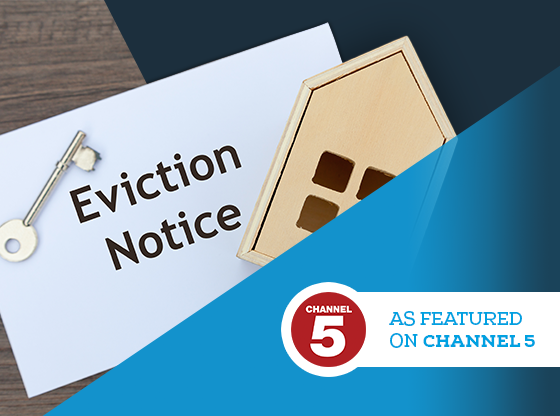Reasonable Recipient Test Applies to Eviction Notices
The Court of Appeal (Pease v Carter & Anr [2020] EWCA Civ 175) has held that the reasonable recipient test applies to eviction notices.
The background to the case is that on 7th November 2018 the landlord served Notices of Proceedings for Possession under s.8 Housing Act 1988 on the tenants. The landlord relied on discretionary grounds 10 & 11 and mandatory ground 8.
The notice was signed and dated 7th November 2018 but there was a typographical error stating that the earliest date proceedings would begin was 26th November 2017 rather than 26th November 2018.
At a first possession hearing the District Judge allowed the landlord to rely on the notice notwithstanding the error. The tenants appealed that decision.
The landlord relied upon the ‘reasonable recipient’ test in the Mannai Investment Co Ltd v Eagle Star Life Assurance Co Ltd [1997] UKHL 19 line of cases. The Circuit Judge found that the reasonable recipient would have realised the date was an error and would have been in no doubt what it should have said. However, relying on Fernandez v McDonald [2003] EWCA Civ 1219 the judge held that the ‘reasonable recipient’ test did not apply to section 8 notices and therefore the notice was invalid.
The landlord appealed to the Court of Appeal on two grounds:
- The Judge was wrong to hold that the reasonable recipient test did not apply to section 8 notices.
- In the alternative, the Judge was wrong to hold that the section 8 notice was not “substantially to the same effect” as the prescribed form.
Arnold LJ delivered the lead judgment. Having reviewed the authorities he concluded, at [39]:
- A statutory notice, such as a section 8 notice, is to be interpreted in accordance with reasonable recipient test derived from Mannai v Eagle, that is to say, as it would be understood by a reasonable recipient reading it in context.
- If a reasonable recipient would appreciate that the notice contained an error, for example as to date, and would appreciate what meaning the notice was intended to convey, then that is how the notice is to be interpreted.
- It remains necessary to consider whether, so interpreted, the notice complies with the relevant statutory requirements. This involves considering the purpose of those requirements.
- Even if a notice, properly interpreted, does not precisely comply with the statutory requirements, it may be possible to conclude that it is “substantially to the same effect” as a prescribed form if it nevertheless fulfils the statutory purpose. This is so even if the error relates to information inserted into or omitted from the form, and not to wording used instead of the prescribed language.
The Court of Appeal considered the inter-action between Fernandez v McDonald and Spencer v Taylor [2013] EWCA Civ 1600 with LJ Underhill noting, at [57], that this had understandably caused some confusion. At [38] Arnold LJ held, contrary to the orbiter comments of Lewison LJ in Spencer v Taylor, that in Fernandez v McDonald Hale LJ (as she was) had not decided that in the case of a s.21(4) notice the court cannot correct obvious mistakes even where the reasonable recipient test was satisfied.
Allowing the appeal the Court went on to hold that:
- Covering letters to the notice could be taken into account when determining how the reasonable recipient would have interpreted the notice [45].
- Statutory notices are to be interpreted in accordance with Mannai v Eagle. Contrary to what the Judge thought, Fernandez v McDonaldis not authority for the proposition that this approach is inapplicable in relation to s.8 notices [47].
- In this case, given that the date of 26 November 2017 was an obvious typographical error and that a reasonable recipient would have understood that the intended date was 26 November 2018, the Notices did serve the statutory purpose of giving the Tenants at least two weeks’ warning of the commencement of proceedings [53].
- The Judge was also wrong to hold that the Notices were not “substantially to the same effect” as the prescribed form. That test applies to information inserted into the form and not just to the wording used [54].
The Court also rejected an argument by the tenant that the circuit judge had erred in concluding that it was clear to the reasonable recipient what the intended date was [44].
The Court held that the reasonable recipient test applies to eviction notices.
So what is the reasonable recipient test?
The reasonable recipient test was established in the House of Lords case of Mannai Investment Co Ltd v Eagle Star Life Assurance Co Ltd [1997] AC 749. In this case the court had to consider whether a notice to quit served by a tenant on the landlord to terminate the lease was valid.
The respondent company was the landlord, and the appellant company was the tenant. The relevant clause was clause 7(13), which provided as follows:
“The Tenant may by serving not less than six months notice in writing on the Landlord or its Solicitors such notice to expire on the third anniversary of the term commencement date determine this Lease and upon expiry of such notice this Lease shall cease and determine and have no further effect. . . .”
So the clause gave the tenant a single opportunity to bring the lease to an end. It so happened that the market for rents in this area had fallen, and the tenant decided to take advantage of this opportunity and served the following notice on the landlord:
“Pursuant to Clause 7(13) of the Lease we as Tenant hereby give notice to you to determine the lease on 12 January 1995. . .”
Unfortunately, however, the tenant made a mistake on the notice. The third anniversary of the term commencement date was not 12 January 1995 but 13 January 1995. The landlord claimed that because of the error on the notice the notice was invalid. The Court of Appeal, upheld the landlord’s contention. However, the tenant appealed the courts decision.
On appeal the court determined the notice to quit was valid by asking how a reasonable recipient would have understood it. If the recipient would be left in no doubt about what was meant by the notice, despite an error in it, then it would be valid.
The court clarified that the reasonable recipient test does applies to eviction notices which means a landlord may be able to rely on an eviction notice even if there is an error on the notice. It is important to note however most eviction notices are prescribed forms, therefore if there is a significant error made, such as failing to complete all parts of the notice, then the reasonable recipient test may not save the validity of the notice.
If, despite the error on an eviction notice, the reasonable recipient would be able to understand what was meant by the notice, the notice would in most cases be valid. The reasonable recipient test applies to eviction notices and this means that landlords that a possession claim will not automatically fail based on a defective notice.
The reasonable recipient test is not the only principal that could save the validity of a notice
Evictions notices can, in most cases, be provided in ‘a form substantially to the same effect’ as the version prescribed by law.
Notices being prescribed by law means there is a specific form of notice, the prescribed notice must contain the information required by statute. Form 6A, Section 21 of the Housing Act 1988, is for example, a prescribed form in England.
If there is an error on a notice given by a landlord to the tenant, there is to be a comparison between the notice with the error on, and what the correct notice should look like. If there is little to no difference in substance, then the notice containing an error should be taken to be substantially to the same effect as that prescribed (see case law).
An alternative argument that a notice is valid, despite errors, is that the notice has still met its legislative purpose. In the case of [case] the court held that where a prescribed form had met its legislative purpose, the notice would be valid, despite errors.
What does this mean for landlords?
Although the reasonable recipient test applies to eviction notices, of course, notices should be correct from the outset to prevent any contention as to the validity of the notice served. However, there are useful principals that may aid landlords in the events a notice containing an error is served. These principals will apply to almost all notices in relation tenancy, license and lease agreements.
Should you have any queries please contact our team.
About the Author: Sasha Charles specialises in property and family law and regularly attends court for landlord and tenant matters.











